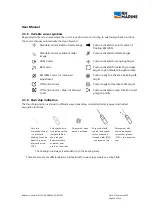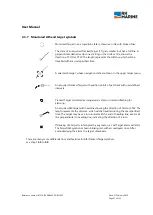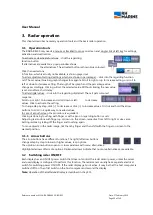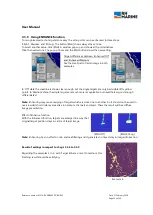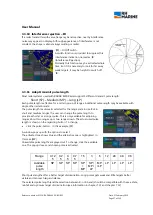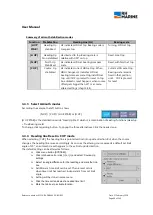
User Manual
Reference number: 4111A-RADAR4600-GBD-R1.1
Date: 27 February 2018
Page 37 of 149
3.3.10
Interference rejection – IR
If a radar transmitter with same frequency band is active, nearby interference
noise may appear on display. Although appearance of interference is not
constant, the shape is almost always swirling or radial.
[IR] – On/Off switch
A switch function is provided to suppress this
interference indication, named as ‘IR’
(Interference Rejection).
Normally this function may be activated whole
time. But if it is necessary to look for far away
weak targets, it may be helpful to switch off
‘IR’.
3.3.11
Adapt transmit pulse length
Most radar systems used with RADAR 4600 Radar support 3 different transmit pulse length:
Short (SP) – Medium (MP) – Long (LP)
Each pulse length is effective for a certain group of ranges. Additional pulse length may be available with
single other radar brands.
The pulse length is automatic selected for the range scale in use. But in
short and medium ranges, the user can change the pulse length, to
provide a shorter or a longer pulse. This is only available for adjoining
ranges, about two ranges up or two ranges down. The actual used pulse
length is shown on the regarding button. To change,
click the pulse-button - in this example [SP].
A window pops up with the options to select.
The activated one shows blue and the alternative one is highlighted, in
this case [MP].
Unavailable pulse lengths are greyed out. To change, click the available
one. The popup closes and chosen pulse is activated.
Range
0.12
5
0.2
5
0.
5
0.7
5
1.5
3
6
12
24
48
96
Available
pulse
length
SP
SP SP
SP SP
/
MP
SP /
MP /
LP
MP
/LP
LP
LP
LP
LP
Short pulse lengths offer a better target discrimination. Long pulses gets weak and little targets better
visible and can reach larger distance.
The selected pulse length (and the selection between X- or S-band) should be compatible with the sea state,
rainfall and optimum target discrimination (see information in chapter 7.11 and chapter 7.12)




